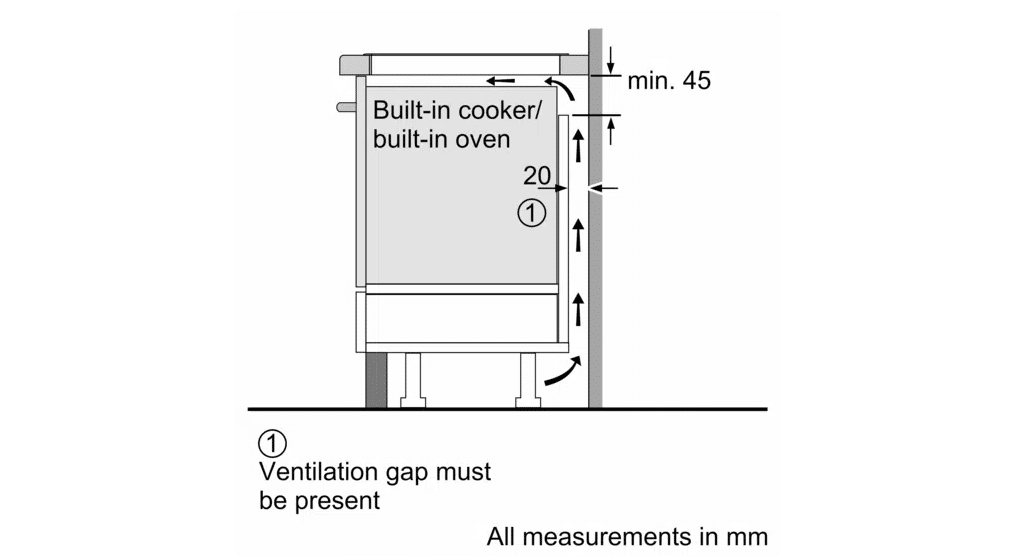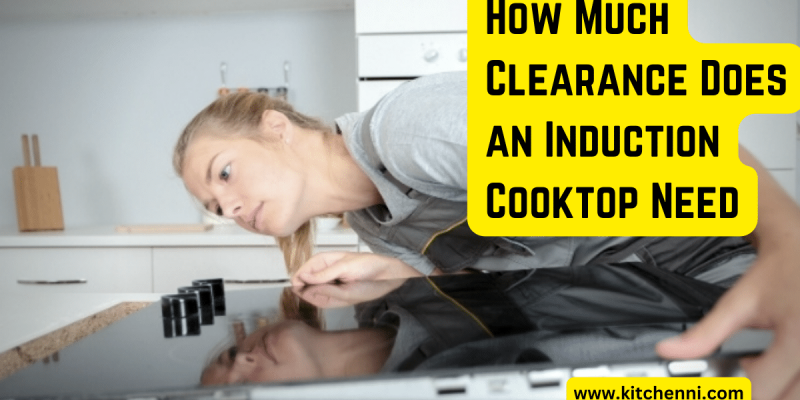A typical induction cooktop should be located at least 600 mm below an unprotected cabinet and 50 mm from a splashback.
Sadly, very few people know the clearance requirements for induction cookers. That is despite the growing global induction cooktop market, which predictions expect to hit $35.91 billion by 2028, and many households switching to induction cooking. And the consequences are evident, from poor ventilation to prematurely damaged appliances and voided warranties.
Would you like to avoid the problems associated with insufficient clearance around an induction cooktop? You’re in the right place.
How Much Space Do You Need Around an Induction Cooktop?
Generally, an induction cooktop should be approximately 50 mm away from the splashback. This distance is from the appliance’s back edge to the splash back, which protects the nearest kitchen wall from heat and moisture damage.
“Induction cooking relies on airflow to keep components cool. While some models can operate with as little as 1.5 to 2 inches of clearance, I’d feel better with 3 to 4 inches all around for optimal performance and safety.” – Bob Johnson, Johnson Home Repairs

You should never position your cooker too close to the splashback because it can lead to frequent and excessive accumulation of grime and grease on the surface. Plus, cleaning the splashback can be a nightmare when the gap between the panel and an appliance is too small or nonexistent.
Furthermore, ideally, an induction cooktop should have 150-300mm of clearance on each side. That is indispensable because it provides enough space for ventilation.
Note that there are no specific requirements or set rules. The numbers recommended here are simply the best for practical use and safety. Depending on your needs and preferences, you can leave less or more space around your cooktop.
Which Induction Cooktop Required the Least Clearance Above?
Ideally, there should be a clearance of around 600mm between an induction cooktop and the lowest surface on an unprotected metal or wood cabinet. But some products, like the Bosch Benchmark FlexInduction Cooktop, have lower requirements.
“Make sure to leave enough open space around your induction cooktop. This not only prevents overheating but allows you easier access for cleaning spills and splatters.” – David Lee, Lee’s Appliance Repair
That said, the amount of clearance that should be above a specific induction cooktop depends on numerous factors, including:
- Local Building Codes: In some regions, local building codes dictate various aspects of induction cooktop installation, from the correct voltage and frequency to space and clearance. Before installing your appliance, check if local ordinances have anything to say about the minimum clearance that should be above it.
- Manufacturer Specifications: Most reputable cooking appliance manufacturers specify clearance requirements in their user manuals. Check if the manual that came with your cooktop outlines any clearance recommendations.
- Cookware Size: Many people forget to factor in cookware size while installing a cooktop. If you plan on using tall cooking pots on your induction hob, you’d be safer with more clearance between the cooktop and anything above it, be it a cabinet or ventilation hood.
How High Should an Extractor Fan Be Above an Induction Hob?
Admittedly, excess fumes, odors, and steam can make your kitchen unpleasant to cook in. But with an extractor fan, you can keep all these elements at an absolute minimum.

That said, an extractor fan can lead to other problems if it’s incorrectly positioned. For instance, if it’s positioned too low, its ability to effectively capture and get rid of smoke and steam might be impaired. It can also make cooking a nightmare, especially when activities that require constant tossing and flipping are involved. A good example is when you’re sautéing meat or veggies.
To ensure your extractor fan does its job seamlessly without interfering with anything, ensure it’s at least 650 mm above an induction cooktop.
Is it Mandatory to Have an Extractor Above Your Hob?
No. In most regions, installing an extractor hood above an induction cooker is not legally mandated. So, to answer your question, having an extractor above your cooktop isn’t mandatory. But it’s advisable. As mentioned, the fan in an extractor hood removes excess steam, fumes, smoke, etc., from the air in your kitchen.
But if you don’t like extractor hoods, various other items can help. These include a recirculation hood, which pumps the air extracted from your kitchen through a filter and then recirculates it back into the kitchen. The primary benefit of using a recirculation hood is it doesn’t require extensive ductwork, which is otherwise necessary in extractor hoods.
Can You Install an Induction Cooktop Above the Drawers?
Yes, installing an induction cooker above a drawer is possible. And don’t worry about the bottom of the cooktop becoming hot and damaging your drawers because it’s unlikely to happen. Remember, induction hobs are designed to heat cookware without affecting anything else.
But, to be safer, install a hob separator plate between your cooktop and any drawer below it. It will stave off countless issues, from sharp appliances scratching the cooker’s bottom to utensils shuffling around and getting caught on loose wires.
Can You Install Induction Cooktop Hobs Over a Built-Under Oven?
Yes. Installing an induction hob over a built-under oven is possible, but requires some special considerations. Induction cooking relies on electromagnetic waves, so it’s important to ensure there is adequate clearance between the hob and oven.
Most manufacturers recommend a minimum gap of 30mm between induction hobs and ovens. This allows for proper ventilation and prevents residual heat from the oven from affecting the hob. Without sufficient clearance, the induction hob may overheat or not function correctly.

Ventilation is key for any oven and hob combination. Built-under ovens require cutouts in cabinetry for airflow. When adding an induction hob on top, the ventilation requirements must still be met. This may require additional vent holes cut in the cabinet top. Proper ventilation prevents issues like moisture damage.
The induction hob must also be securely installed and sealed to the countertop. This provides stability and prevents spills, grease, and debris from falling into the oven cavity. The hob should be installed according to the manufacturer’s specifications.
With proper planning, clearance, and installation, an induction hob can successfully be combined with a built-under oven. This configuration maximizes cooking options and space in your kitchen. Just be sure to consult appliance specs and work with experienced kitchen fitters.
Key Takeaway
As we’ve discussed, an induction cooker needs space around it. That is why, ideally, your cooktop should be around 50 mm from the splashback and 650 mm from the ventilation hood or unprotected drawers. We’ve also mentioned that the exact clearance requirements depend on aspects like manufacturer specifications and local ordinances.
Keep everything we’ve said here in mind when installing an induction hob. And remember, you don’t need to place your cooktop on an unoccupied part of your kitchen floor or cut a hole in your counter for the appliance. You can easily install it on top of existing cutlery drawers and save much-needed space.
Common Questions
Why does an induction cooktop need more clearance than a gas or electric cooktop?
Induction cooktops generate a lot of ambient heat under the cooking surface. This heat needs proper ventilation to prevent internal components from overheating. Gas and electric cooktops dissipate heat more openly, requiring less concentrated airflow.
What is the standard recommended clearance for induction cooktop installation?
Most manufacturers recommend leaving at least 3–4 inches of clearance on all sides and at the rear of the cooktop. Some models may work with 2–3 inches, but more open space is ideal.
Does overhead clearance above the cooktop matter?
Yes. You should have at least 18 inches of open space between the induction cooktop surface and the bottom of any cabinets or overhead fixtures. This prevents heat accumulation and allows you to cook safely.
What issues can arise from insufficient clearance around an induction cooktop?
Lack of ventilation can lead to overheating, damaged components, reduced performance, automatic safety shut-offs, and a higher risk of fire. Insufficient overhead room can also make cooking difficult and dangerous.
Should I leave extra clearance if installing next to a wall or within cabinetry?
Yes, allow a few extra inches of clearance from any walls or confined spaces. Induction cooktops in tight spaces are more prone to ventilation issues and overheating without ample room to dissipate heat.
What about clearance between the cooktop and backsplash or countertop edges?
Leave at least 2 inches of space between the back and sides of the cooktop to any backsplashes or countertop edges. This helps prevent heat damage and allows air to flow freely.
